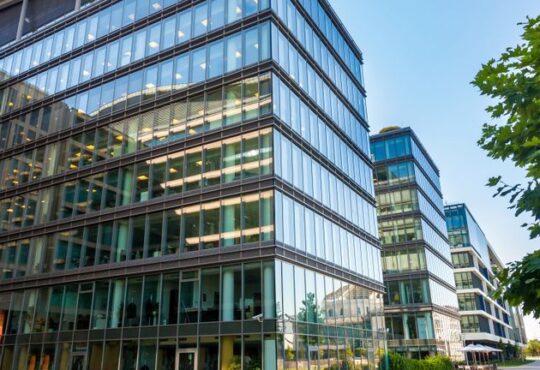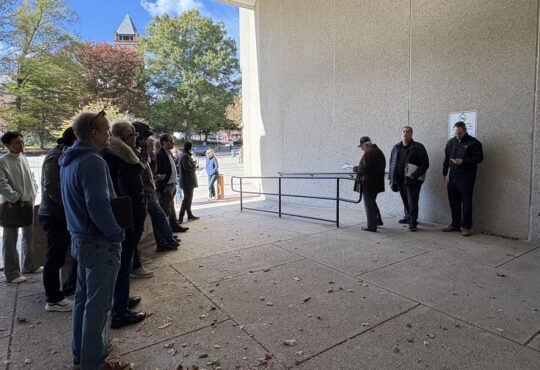Retail’s Been Resilient In 2025. ‘Relentless’ Instability Threatens The Holiday Party

Retail real estate has been on a roll. Investment sales are up significantly, distress is falling, the leasing market is still competitive, and a limited amount of new construction is buoying long-term fundamentals.
But the industry is battling fierce macroeconomic headwinds, from on-again, off-again tariffs to waning consumer sentiment and an increasingly shaky job market.
This holiday season is poised to clarify a landscape mired in uncertainty and define which of the competing headwinds and tailwinds ultimately wins the day.
“We’re a capitalist society that is contingent on consumers,” New York-based retail consultant Kate Newlin said. “I think the relentlessness of change now and uncertainty has a corrosive effect on the consumer’s ability to say, ‘Wahoo, I’ve got $1K left of credit on my MasterCard. Let’s party.’”

Bisnow/created with assistance from ChatGPT
Holiday spending growth is expected to be more muted this year.
A lot is on the line this holiday season: November and December have represented nearly 20% of annual retail revenue nationwide since 2019, according to Avison Young’s 2025 holiday retail trends report.
Deloitte is forecasting a 2.9% to 3.4% increase in total 2025 holiday sales compared with the same period in 2024, which would be the smallest increase since at least 2016 and well below last year’s 4.2% sales growth.
Demand for shopping center space improved in the third quarter, as net absorption turned marginally positive at 323K SF. As of Q3, national retail investment volume was $64.6B over the trailing 12 months, according to MSCI Real Capital Analytics. That figure was 21.7% higher than a year earlier.
“Even before rates started to come down this year, we saw that activity picking up,” said Meghann Martindale, principal and director of retail market intelligence at Avison Young. “That pent-up demand and that pent-up activity started to shake loose.”
It is taking time for the full impact of macroeconomic headwinds to hit, since retailers are only now feeling higher costs of goods, said James Bohnaker, senior economist at Cushman & Wakefield. Many stocked up to try to get ahead of tariffs, delaying their effects.
The real pressure may come in 2026, when rising costs and slowing sales could push companies to cut expenses, including real estate.
“Though we haven’t seen a lot of pullback in terms of leasing volume yet related to tariffs and just the broader economic uncertainty, I would not be surprised to have a pretty subdued holiday period from a sales perspective, and that potentially leading into a somewhat softer leasing environment in 2026,” Bohnaker said.
Retail demand rebounded in the third quarter after bankruptcies and closures announced in 2024 hit the market and led to negative net absorption. Year-to-date net absorption for shopping centers registered negative 13.1M SF, putting the market on track for the first year of negative demand since 2020, according to Cushman & Wakefield.
Although store openings have outpaced closures over the last several years, the scale might tip this year, Martindale said.
Coresight Research tracked 5,822 store closings in 2025 through June 27, representing an estimated 123.7M SF of retail space. That is up from 3,496 in the same period last year. Closures are expected to outpace openings through year-end by 50%, according to Coresight.
But Martindale said she isn’t concerned the trend will impact investment volume.
“It’s not necessarily a dire thing for the industry, because we’ve had a lot of space locked down for so long, and investors and owners want to re-lease that space,” Martindale said.
Many of the newly vacated blocks are tied to major retailers that were having problems before new trade policies and a weakening economy. Big Lots, Party City and Joann announced their respective bankruptcies before the Trump administration took office and have been aggressively closing stores throughout this year.

Big Lots, Party City and Joann announced their respective bankruptcies before the Trump administration’s tariffs.
“Retail has been pretty resilient from a real estate standpoint,” Bohnaker said. “Rising vacancy can be pretty directly traced back to non-tariff-related trends, or things that had happened in 2024 with some large bankruptcy announcements and store closures, and so isn’t really reflective of a market that’s weakening.”
But that could change. The industry is navigating mercurial tariff policies, a weakening labor market, softening consumer sentiment and what is rapidly approaching the longest government shutdown in U.S. history.
So far, businesses have been bearing the brunt of the tariffs, not consumers.
Average retail prices for imported items were just 2% higher in August 2025 than in October 2024, according to an ongoing academic study. But the Peterson Institute for International Economics found that in July, tariffs on imported consumer goods made up about 13% of the total value of monthly imports.
That indicates tariffs hadn’t completely filtered into retail prices yet.
Brad Belden, senior vice president at Colliers, said he has had a few deals fall through because tariffs have extended timelines for some prospective tenants to get equipment from overseas. Those tenants have stalled and ultimately killed leases while they wait for materials to arrive because they don’t want to pay rent for an empty location or exhaust a landlord’s free rent offer while not operational.
“It’s more difficult to get things in a timely manner, and time is money to a tenant,” Belden said.
Major cuts from retail heavyweights could portend real estate distress.
Outplacement firm Challenger, Gray & Christmas expects 2025 seasonal retail hiring to fall to its lowest point since the recession-plagued season of 2009. The firm projects retailers may add fewer than 500,000 positions in the last three months of 2025, the lowest figure in 16 years.
“A wave of uncertainty is impacting not just retailers, but also consumers heading into the final quarter of the year,” Challenger said in a statement. “With hiring slowing across the board, retailers may hire fewer workers themselves, while many of their shoppers slow spending.”
Amazon will eliminate as many as 30,000 corporate jobs, 10% of its corporate workforce, beginning this week, as the company seeks to trim expenses and correct for overhiring during the peak demand of the pandemic, Reuters first reported.
Target said last week it would cut 1,800 corporate jobs, the first major round of layoffs for the retailer in a decade.

Bisnow/Mark F. Bonner
The new Target store at East 86th Street and Lexington Avenue on Manhattan’s Upper East Side.
Children’s apparel giant Carter’s is set to close 150 stores and lay off 300 office employees, blaming steep import tariffs and rising costs for slimmer profit margins.
Consumer confidence declined again in October, according to The Conference Board. Americans’ short-term expectations for income, business and labor market conditions have been below the threshold that typically signals a recession since February.
Consumers expect to spend 3.9% less on gifts and 12% less on other items compared to last year, according to The Conference Board. They frequently cited promotions in driving spending decisions and also indicated that they will likely buy fewer goods if prices are inflated by tariffs.
It takes some time for falling consumer spending to trickle into real estate impact, Martindale said.
“Typically, this time of year is our peak spending period, and so there’s sort of always an artificial lift,” she said. “My concern really is heading into the first quarter when all of that dissipates, and we might finally start really feeling the effects of tariffs and pullback in spending.”
And the instability surrounding retail is “relentless,” Newlin said. Unlike the pandemic or the Great Recession, when there were clear causes and effects to distress, the modern-day situation is far murkier.
“The reality is people feel it,” Newlin said. “They feel the instability, and it’s coming at them from multiple sources.”






